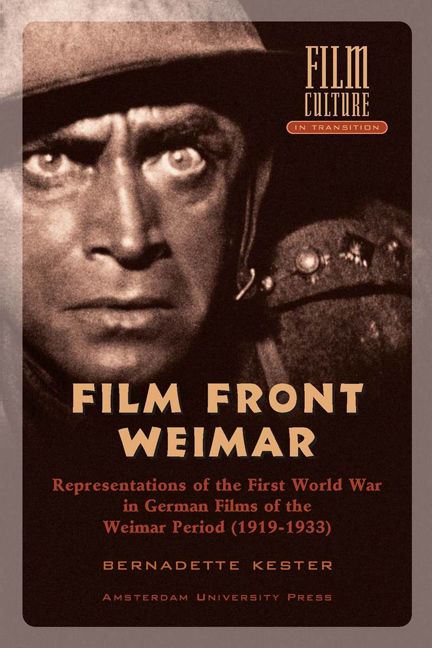 Filmfront Weimar
Filmfront Weimar Book contents
- Forntmatter
- Contents
- Preface and Acknowledgements
- Introduction
- Chapter 1 ‘Lehrreich Und Amüsant’ – Historical Films in the Period 1896-1933
- Chapter 2 ‘Die Legende von der Unschuld’ – Films about the Run-Up to the war, Especially 1914. DIE LETZTEN TAGE VOR DEM WELTBRAND
- Chapter 3 ‘Das Dokumentarische Gewinnt die Oberhand’ – Archival Footage and Constructions in War Films
- Chapter 4 ‘Wenn Wir Helden Wären, Wären Wir Schon Längst Daheim’– Realism and Anti-War Tendencies in Four Films
- Chapter 5 ‘Auf Dem Meere, Da Ist Der Mann Noch Etwas Wert’ – Films About the German Navy During The First World War
- Chapter 6 ‘Neid, Leid, Tränen – Das Ist Der Krieg’– Gender and War Films
- Epilogue
- Notes
- Credits Weimar War Films
- Archives and Libraries
- Bibliography
- Index of Names
- Index of Subjects
Chapter 1 - ‘Lehrreich Und Amüsant’ – Historical Films in the Period 1896-1933
Published online by Cambridge University Press: 15 January 2021
- Forntmatter
- Contents
- Preface and Acknowledgements
- Introduction
- Chapter 1 ‘Lehrreich Und Amüsant’ – Historical Films in the Period 1896-1933
- Chapter 2 ‘Die Legende von der Unschuld’ – Films about the Run-Up to the war, Especially 1914. DIE LETZTEN TAGE VOR DEM WELTBRAND
- Chapter 3 ‘Das Dokumentarische Gewinnt die Oberhand’ – Archival Footage and Constructions in War Films
- Chapter 4 ‘Wenn Wir Helden Wären, Wären Wir Schon Längst Daheim’– Realism and Anti-War Tendencies in Four Films
- Chapter 5 ‘Auf Dem Meere, Da Ist Der Mann Noch Etwas Wert’ – Films About the German Navy During The First World War
- Chapter 6 ‘Neid, Leid, Tränen – Das Ist Der Krieg’– Gender and War Films
- Epilogue
- Notes
- Credits Weimar War Films
- Archives and Libraries
- Bibliography
- Index of Names
- Index of Subjects
Summary
For a long time, the historiography of German cinema, understood as a complex entity of industry, films, audience and criticism, has been oriented mostly towards the years following the First World War. General studies begin with a description of the first German film screenings, only to make a carefree jump across two decades to the 1920s, a period in which film as art was said to have flourished. Gradually, this historical gap is being closed. Attention to early film has increased enormously since the famous 1978 FIAF conference in Brighton, and it has not passed by German film historians either. In the meantime, several interesting studies have appeared dealing with the first two decades of German film history.
At the end of the nineteenth century, at least two countries in Europe pioneered the development of the film medium. The French Lumière brothers created a furore with their cinematograph, while in Germany, the brothers Max and Emil Skladanowsky stole the (variety) show with a presentation of film images recorded and projected with a home-made device, the so-called Bioskop. Their first public presentation took place in Berlin’s Wintergarten on 1 November 1895. The programme, typically consisting of a series of short alternating segments, would influence the design of cinema programmes for years to come. However, in the early years of the new medium, film was also distributed by the so-called Wanderkino operating mainly on fairs and similar festivities. Under the caption ‘Neu! Neu! Das Bioskop, die interessanteste Findung der Neuzeit’, a Berlin daily described the first experience with the new medium as ‘lehrreich und amüsant’ – educational and entertaining. In the next few decades, the cinema would move between the two poles, education/ entertainment and politics/art. Various social institutions such as religion, education and politics would unleash fierce discussions about the potentially negative and/or positive uses of the film medium.
The presentation of film programmes typically consisting of ten or more very short films about a variety of subjects – such as music, acrobatics, sports, current affairs, drama and humour – drew mixed crowds. Contrary to what has long been assumed, it was not only the lower social classes who were fascinated by film presentations. With the exception of the university-educated ‘Bildungsbürgertum’, the composition of the audience was rather diverse, also in terms of sex and age.
- Type
- Chapter
- Information
- Filmfront WeimarRepresentations of the First World War in German Films from the Weimar Period (1919–1933), pp. 33 - 58Publisher: Amsterdam University PressPrint publication year: 2002


